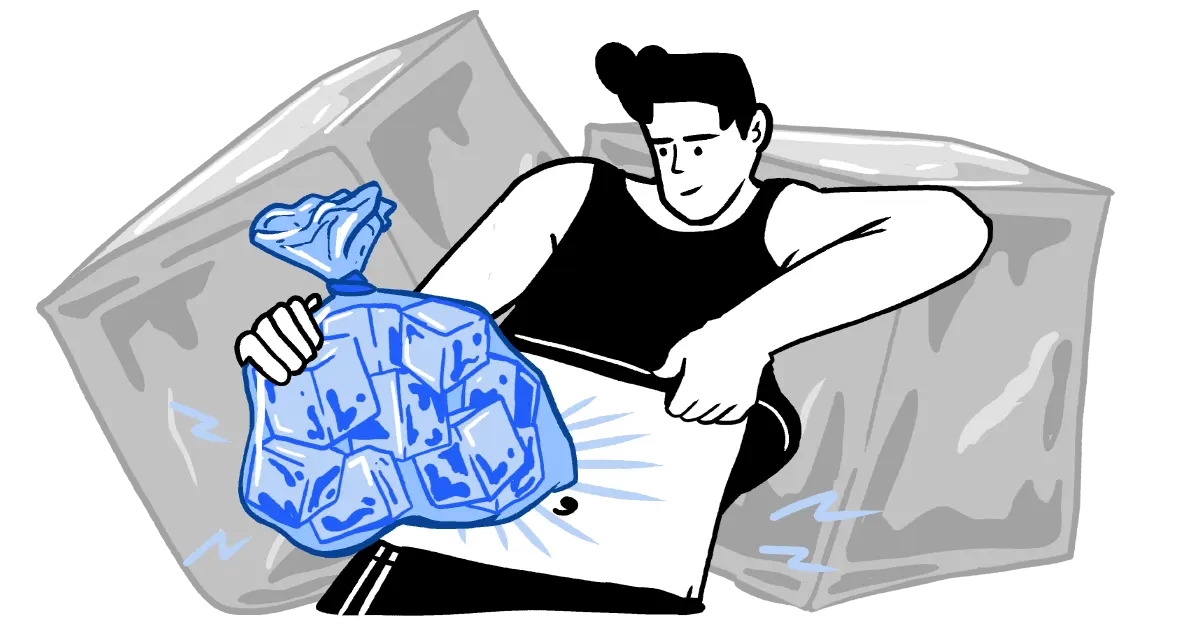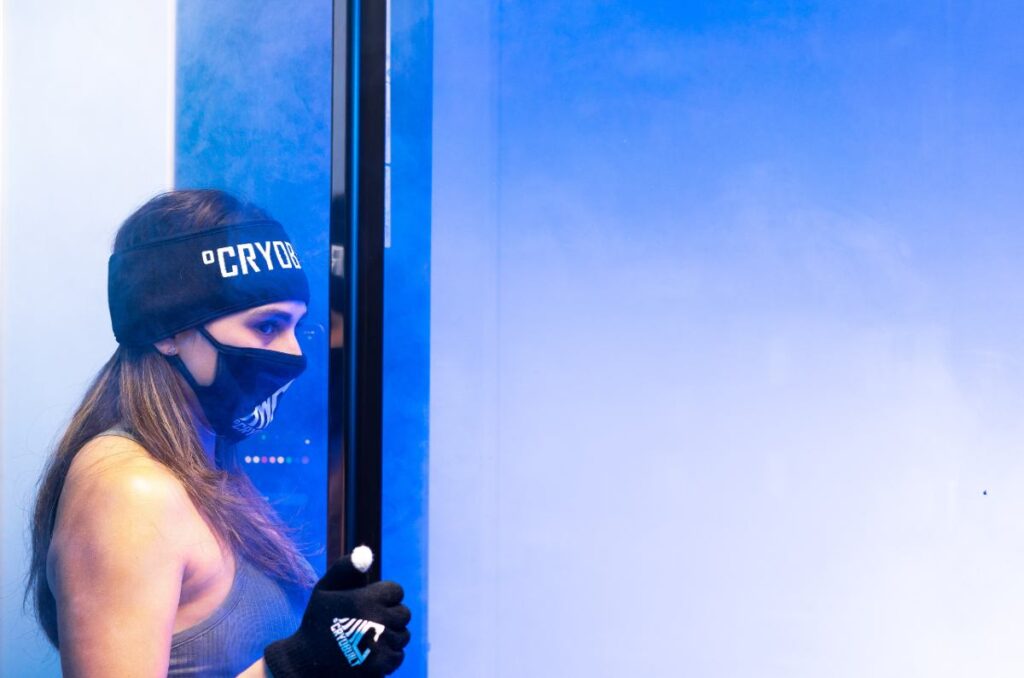
Research indicates that fat cells begin to die when exposed to -1˚C, but it remains unclear if ice packs alone can effectively reduce belly fat.
This could be a myth, or there might be alternatives available.
Can Ice Packs Reduce Belly Fat? (Why or Why Not)
The truth is, if an ice pack strapped on a person’s belly it won’t make a dent on belly fat, but it may burn an insignificant amount of calories since the body is working to keep the stomach warm. This is because the the science behind fat freezing requires precision.
When trends like CoolSculpting and Cryotherapy (cold therapy) spread across the globe people begin to think an ice pack is a viable alternative. But that’s far from the truth.
How Ice Packs Differ From Cold Therapies
By looking into other fat burning cold treatments we can understand why ice packs won’t help anyone lose 70 pounds or destroy stubborn fat. The differences between applying an ice pack and getting an official fat freezing treatment can be seen below:
| Ice Packs Benefits | Official Fat Freezing Treatments |
| Can result in an ER trip due to frostbite (which is similar to a third-degree burn) | Have safety mechanisms in place that protect the skin and other tissues while sculpting body fat |
| Do not offer a way to adjust, monitor, or control the temperature of the fat cells | Has temperature gauges that monitor and recalibrate temperature throughout the treatment |
| Cannot accurately target the fat cell layer, and instead freezes the surface of the skin | Adds a component of suction that holds fat securely in place to target it successfully |
Overall, treating the stomach with an ice pack lacks the science, precision, and safeguards that other fat-freezing treatments may offer.1
Fat Burning Cold Treatments That Work
While some argue that ice packs can reduce belly fat, it’s clear that slapping an ice pack onto the skin won’t kill fat. However, treatments like cryolipolysis and cryotherapy can make a difference, and there’s scientific research backing measured cold exposure and fat loss.
It all starts with the three types of adipose cells: white fat (visceral fat), brown fat (subcutaneous fat), and beige fat (a combination of the two). Researchers have recently discovered that brown cells contribute directly to increased energy expenditure and destroying fat cells. Brown adipocytes are thought to decline to age, which may explain why we become heavier with age. Cold exposure can activate the brown cells, leading to more energy-burning and therefore fat burning.2 New studies show that activating the brown fat cells with cold exposure can reduce obesity and diabetes.3
Here are some effective ways to utilize this insightful research.
Cryolipolysis or CoolSculpting
Cryolipolysis is perhaps the best way to harness the power of fat freezing. In 2010, the first cryolipolysis technology was approved for human use – CoolSculpting. It is approved to treat the thighs, belly, back, under-buttocks, and chin. The average reduction in fat ranges from 10% and 25% per round of treatment.4.
When it comes to CoolSculpting, there’s no cutting, surgery, or stitching. The administrator places a patented freezing applicator on the treatment areas. The patient may experience intense cold and a tugging sensation, followed by numbness.
The CoolSculpting process is clinically proven to freeze fat cells, destroying them permanently. The literature shows that CoolSculpting:
- Is a compelling alternative to liposuction
- Appears to be safe in the short-term
- Results in significant localized fat reduction5
- Delivers high rates of patient satisfaction
In one study, a 46-year-old female patient underwent a 60-minute application of cryolipolysis on the abdominal area. In the ultrasound images, significant fat cell destruction was detected, with consequent fat layer reduction.6 However, the literature also suggests that CoolSculpting is still a new technology and warrants further study in controlled trials.7
CoolSculpting costs $1500 on average, depending on the treatment areas. For someone who wants to learn the ways lose weight in a month without exercise, CoolSculpting can help with the appearance of fat. While it won’t actually help with weight loss, it will help target those bothersome fatty areas.
Cryotherapy

Cryotherapy involves exposing the body to very cold temperatures for a short amount of time. Localized ice therapy/cryotherapy might involve an ice bath, probes, or coolant sprays, whereas whole body cryotherapy might include an ice-water plunge, an immersion tank, or a freezing chamber.
The proclaimed benefits of cryotherapy include:
- Reduced arthritic pain and faster recovery from sports injuries or soreness (due to decreased inflammation)
- Improved mood (due to the release of hormones like adrenaline and endorphins)
- Better skin (due to higher antioxidant levels)
- Weight loss (due to brown fat cell activation)
One study showed that after 20 cryotherapy treatments, menopausal women did show reduced abdominal obesity due to thermogenesis; however, clinical evidence on cryotherapy is slim. A single cryotherapy session can run between $20 and $80.8, 9
Is Ice Pack Therapy, Cryotherapy, or CoolSculpting Worth It?
It is natural to wonder whether ice packs can reduce belly fat because there is plenty of evidence that cold temperatures destroy fat cells. The question concerns the correct approach to take.
- Ice Pack Therapy
Is proven to produce systemic hormonal and anti-inflammatory effects, which can help with recovery from soreness or reduce arthritic pain.10
Although ice pack therapy is accessible, it’s also ineffective at “melting” belly fat and not worth the risks it poses. Applying an ice pack to the bare skin will cause frostbite, which can lead to long-lasting health problems like stiffness and pain. So in other words, ice packs should be primarily used on injuries like back aches to flight inflammation. In addition to icing the area, an easy diet for back pain can help reduce the inflammation as well.
- Cryotherapy
Alternatively, cryotherapy is somewhat affordable, and it has been around for thousands of years. One Dutch study even suggested that cryotherapy activates the brown fat cells, therefore increasing energy expenditure and reducing fat. However, there were only 17 people in this particular study, so more research is needed.11 While its effect on fat freezing is unproven, cryotherapy is purportedly helpful for muscle recovery, better moods, and sounder sleep.
- CoolSculpting
CoolSculpting has the most clinical research behind it. It results in a 20-25 percent decrease in visible fat – however, it is not a weight-loss technique, because the total fat cells eliminated with the process weigh less than a single pound! For someone who is very close to their goal weight, CoolSculpting may help them achieve the body shape they want, but it won’t help them lose weight. When it comes to losing significant weight, an individual needs an exercise routine and a diet plan focusing on meal nutrition for effective weight loss.
For those still asking whether ice packs can reduce belly fat, please be cautious. Exposure to cold temperatures may burn a few calories, but an ice pack is more likely to result in frostbite than destroy fat. The best technologies may help someone contour and define the body, but remember – the best success comes from consistent diet and exercise.
References
1Savacini, M. B., Bueno, D. T., Molina, A. C. S., Lopes, A. C. A., Silva, C. N., Moreira, R. G., Almeida, S., Guidi, R. M., Sant’Ana, E., & Liebano, R. E. (2018). Effectiveness and Safety of Contrast Cryolipolysis for Subcutaneous-Fat Reduction. Dermatology Research and Practice, 2018, 1–9. <https://doi.org/10.1155/2018/5276528>
2Loap, S., & Lathe, R. (2018). Mechanism Underlying Tissue Cryotherapy to Combat Obesity/Overweight: Triggering Thermogenesis. Journal of Obesity, 2018, 1–10. <https://doi.org/10.1155/2018/5789647>
3How brown fat improves metabolism. (2019, September 17). National Institutes of Health (NIH). Retrieved January 21, 2022, from <https://www.nih.gov/news-events/nih-research-matters/how-brown-fat-improves-metabolism>
4Nathan, N., MD. (2020, March 12). The skinny on freezing fat. Harvard Health. Retrieved January 21, 2022, from <https://www.health.harvard.edu/blog/the-skinny-on-freezing-fat-2020031218990>
5Ingargiola, M. J., Motakef, S., Chung, M. T., Vasconez, H. C., & Sasaki, G. H. (2015). Cryolipolysis for Fat Reduction and Body Contouring. Plastic and Reconstructive Surgery, 135(6), 1581–1590. <https://doi.org/10.1097/prs.0000000000001236>
6Meyer, P. F., Silva, R. M. V. D., Oliveira, G., Tavares, M. A. D. S., Medeiros, M. L., Andrada, C. P., & Neto, L. G. D. A. (2016). Effects of Cryolipolysis on Abdominal Adiposity. Case Reports in Dermatological Medicine, 2016, 1–7. <https://doi.org/10.1155/2016/6052194>
7McKeown, D. J., & Payne, J. (2021). Significant improvement in body contour with multiple cycles of CoolSculpting: Results of a prospective study. Dermatologic Therapy, 34(2). <https://doi.org/10.1111/dth.14850>
8Wiecek, M., Szymura, J., Sproull, J., & Szygula, Z. (2020). Whole-Body Cryotherapy Is an Effective Method of Reducing Abdominal Obesity in Menopausal Women with Metabolic Syndrome. Journal of Clinical Medicine, 9(9), 2797. <https://doi.org/10.3390/jcm9092797>
9Shmerling, R. H., MD. (2018, April 18). Cryotherapy: Can it stop your pain cold? Harvard Health. Retrieved January 21, 2022, from <https://www.health.harvard.edu/blog/can-cryotherapy-stop-your-pain-cold-or-is-just-a-lot-of-hot-air-2018041813612>
10Nemet, D., Meckel, Y., Bar-Sela, S., Zaldivar, F., Cooper, D. M., & Eliakim, A. (2009). Effect of local cold-pack application on systemic anabolic and inflammatory response to sprint-interval training: a prospective comparative trial. European Journal of Applied Physiology, 107(4), 411–417. <https://doi.org/10.1007/s00421-009-1138-y>
11Van der Lans, A. A., Hoeks, J., Brans, B., Vijgen, G. H., Visser, M. G., Vosselman, M. J., Hansen, J., Jörgensen, J. A., Wu, J., Mottaghy, F. M., Schrauwen, P., & van Marken Lichtenbelt, W. D. (2013). Cold acclimation recruits human brown fat and increases nonshivering thermogenesis. Journal of Clinical Investigation, 123(8), 3395–3403 <https://doi.org/10.1172/jci68993>